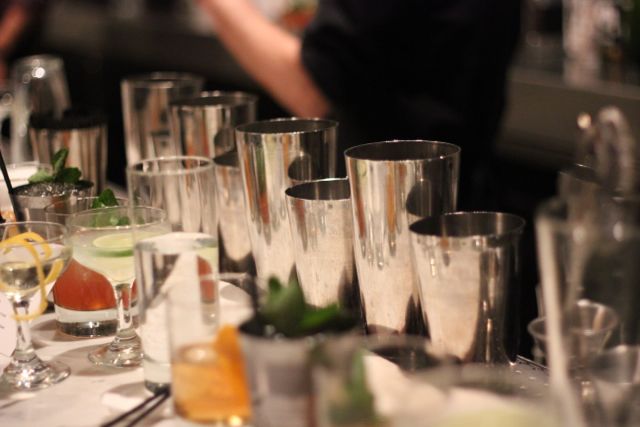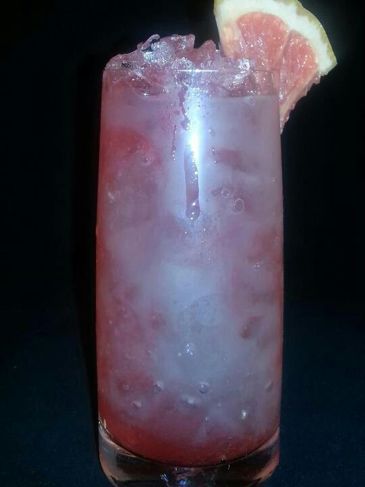"We Want... A Shrubbery" Or How I Learned to Love Drinking Vinegar
By Paul Leddy in Food on Apr 22, 2013 6:00PM

Looking at cocktail lists around Chicago, you would think that bartenders already have spring on their minds. Ingredients called "shrubs" are appearing in cocktails and you might be surprised (or relieved) to find out that they have nothing to do with the plants outside your house, nor is it a secret ingredient known only to Monty Python Fans. Instead, they are a combination of fruit, sugar and vinegar that lets bartenders add a whole new dimension to some of your favorite drinks.
Before we talk about shrubs, though, let’s look at the role of acid in drinks. In many cocktails, a citrus of some sort, usually lemon, lime, orange, or grapefruit fills the role as an acid. The acid component gives the cocktail the “zing” that plays with the sides of your tongue that detects sour flavors. Even in regular, non-alcoholic drinks like Coca-Cola, there are acids added (in that case, phosphoric acid) to give the same zippy effect. Before you get all up in arms about phosphoric acid in soft drinks, don’t forget our great-grandparents and grandparents were drinking cherry phosphate sodas in shops when they were kids. The result was the same: the acids help to give our tongue’s sour taste bud receptors a little culinary wake-up call.
The problem with citric acids, especially in cocktails, is that it can be limiting when trying to develop flavors and maintain balance. Many bartenders create flavor-infused syrups, but they can be a double-edged sword since they can sometimes add too much sweetness to a drink.
An alternative that infuses flavors but still gives needed acidity can be found in a process that dates back to the 1700s. A "shrub" is an acidulated drink that is made with fruit, sugar, and vinegar. The word shrub, as David Solmonson from the 12bottlebar blog discovered in his fantastic research on the history of shrubs, comes from the Arabic term sharab (‘to drink’)” and was first mentioned in the Oxford English Dictionary in 1741.
"Shrubs go back to Elizabethan times and here in the states they were very popular in colonial times," explains Lynn House, head bartender from Blackbird Restaurant. "Vinegar was how you preserved fruit before there was refrigeration."
The history of shrubs with cocktails is very similar to bitters: they had medicinal uses before being used in drinks. Solmonson also found that British sailors would use shrubs to help with symptoms like fevers, inflammations or fatigue.
In Chicago, shrubs have been in use in cocktails for years but has recently ramped up. Mixologist Lynn House used them in a cocktail she created when she worked at Graham Eliot five years ago. “Blueberry Hill” used a housemade blueberry basil shrub that helped House get national attention. "I have done several cocktails using homemade shrubs as well as premade shrubs," House explains. "I have made shrubs using almost every type of fruit, (but) probably the most unique was basil. It was difficult to work with, but after much trial and error, I came up with a formula that worked."
The choice of vinegar to use in a shrub can depend on the fruit base being used. Mike Ryan, head bartender from Sable Kitchen and Bar, says “balsamic is great, especially when incorporating strawberries, richer fruits, or tea notes. For lighter, less robust flavors, I’ll use a champagne vinegar or white wine vinegar.”
Jan Henrichsen, Beverage Director at Found Kitchen, finds that shrubs are cleaner in taste than citrus. "The perfect shrub has acidity, fruit and the finish of whatever spice was used." Young shrubs can sometimes be harsh. “The shrub mellows as it ages,” she added, “it begins to take a life of it’s own.”
So what do people say when they have a cocktail made with a shrub? “People are always scared when they hear vinegar,” explains Nick Smith from L’etage, “but I am never afraid to let someone try a little of it. They get it once they have tasted it.”
Mike Ryan agrees. “Obviously, their tongue is picking up on the acidity and they ask ‘what is that?’ (but) we have gotten people used to drinking citric acid and bitter flavors, taking it a further step to malic or acetic acid isn’t that far a leap, but it is an intuitive one.”
Shrubs are incredibly easy to make at home. In his book, “The New Old Bar: Classic Cocktail and Salty Snacks,” Steve McDonagh wanted the shrubs to be very user friendly. “I want people to make these shrubs at home,” he explains. “What I love about shrubs is it’s that thing that when people are drinking it the say, ‘there is something really cool in there.’”
Toast And Jam
1oz. (30 ml) scotch whisky
1oz. (30 ml) sweet vermouth
.50oz. (15 ml) strawberry balsamic shrub
.25oz. (8 ml) simple syrup
Brandied cherry (for garnish)
Combine the ingredients in a cocktail shaker filled with ice. Shake well. Strain into a chilled coupe and serve garnished with a brandied cherry.
Strawberry Balsamic Shrub
1 cup (200 g) granulated sugar
1 cup (237 ml) water
1 pound (454 g) fresh strawberries, hulled and halved
1 tablespoon whole black peppercorns, cracked
½ cup (119 ml) good-quality balsamic vinegar
Combine the sugar and water in a saucepan and place it over high heat. Bring to a boil and stir to dissolve the sugar. Add the strawberries and black pepper, reduce the heat to medium, and simmer for 8 to10 minutes. Add the balsamic vinegar and simmer for 10 additional minutes. Remove from the heat and allow to cool. Strain to remove the solids and store in the refrigerator until ready to use.
YIELD: Approximately 2 cups (474 ml)
Reprinted with permission from The New Old Bar: Classic Cocktail and Salty Snacks from the Hearty Boys, by Steve McDonagh and Dan Smith, Agate Surrey, 2012
 If you are not keen on making your own shrubs, Brooklyn-based Bittermens makes two uniquely flavored shrubs to use at home: The Hellfire Habanero Shrub and Orchard Street Celery Shrub. Janet Glasser, co-founder of Bittermens, said that for the celery shrub “grew from a classic New York soda called Dr. Brown's Cel-Ray, which is a celery soda that has hints of ginger and apple. Working from there, we started thinking about other flavors from the Eastern European/Jewish immigration experience in the early 1900s, including the pickle vendors associated with Orchard Street in New York's Lower East Side. Taking the celery + ginger combination and adding apple cider vinegar and a pinch of salt gave us a fantastic flavor combination.”
If you are not keen on making your own shrubs, Brooklyn-based Bittermens makes two uniquely flavored shrubs to use at home: The Hellfire Habanero Shrub and Orchard Street Celery Shrub. Janet Glasser, co-founder of Bittermens, said that for the celery shrub “grew from a classic New York soda called Dr. Brown's Cel-Ray, which is a celery soda that has hints of ginger and apple. Working from there, we started thinking about other flavors from the Eastern European/Jewish immigration experience in the early 1900s, including the pickle vendors associated with Orchard Street in New York's Lower East Side. Taking the celery + ginger combination and adding apple cider vinegar and a pinch of salt gave us a fantastic flavor combination.”
Lynn House uses the Bittermens Orchard Street Celery Shrub in her Paloma-influenced cocktail called “Pablo’s Daughter.” “As a child, I was obsessed by the artwork of Pablo Picasso,” House says, ”Ironically, Paloma is the name of his daughter.” “I chose to make a champagne shrub because champagne and grapefruit go together quite naturally.”
Pablo’s Daughter
1.50oz Milagro Silver Tequila
.50oz fresh lime juice
1oz fresh grapefruit juice
.50oz champagne shrub
.08oz Bittermens Orchard Street Celery Shrub
1oz Sanbitter Italian soda
Add first 5 ingredients to a tin, add ice and shake for 5-10 seconds. Pour into a Collins glass with crushed ice and top with the Sanbitter. Garnish with a pineapple wedge.
Even though spring is in the air, hopefully after this little background on shrubs, the only shrub you will be thinking about is the one that you will make at home or order at a cocktail bar.